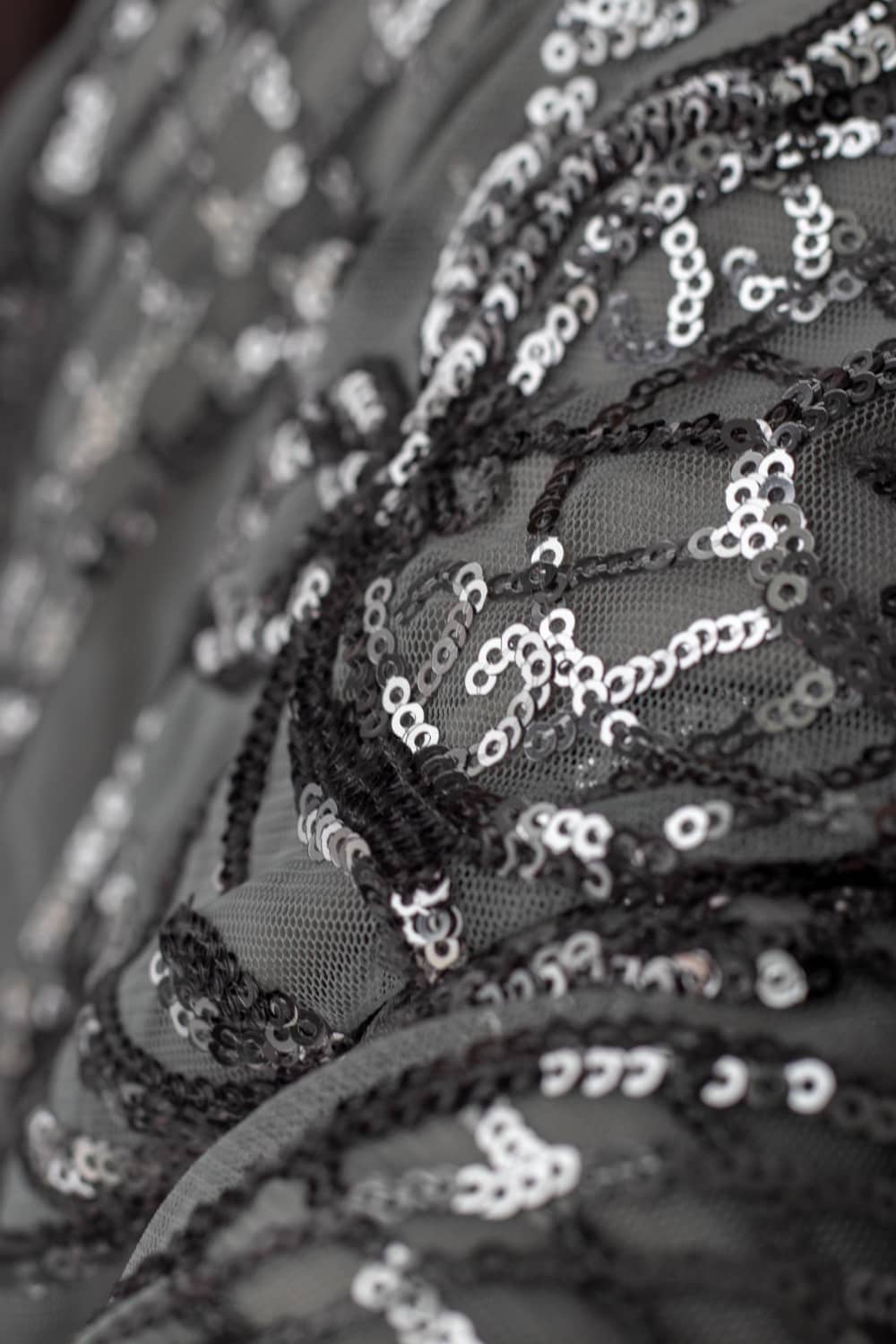Sequinned applications: luxury and creativity in industrial embroidery
In the world of industrial embroidery, sequins application represent one of the most loved and appreciated solutions in the luxury sector. The timeless appeal of sequins lies in their ability to capture light, adding a touch of brilliance and dynamism to fabrics. For decades synonymous with glamour and sophistication, today sequins are finding new interpretations thanks to advanced technologies and increasingly sophisticated demands for customization.
The evolution of sequins in the luxury sector
Once applied manually, sequins are now integrated into industrial processes to ensure precision, speed and quality. State-of-the-art machinery makes it possible to create complex designs with speeds unthinkable just a few years ago, without compromising the craftsmanship that distinguishes luxury products.
The use of sequins has also evolved stylistically. Today we find an endless variety of shapes, sizes and finishes: from classic round and shiny to opaque, transparent, holographic and even biodegradable. This diversity allows for applications that suit every style and need, from sophisticated minimalism to contemporary baroque.

Applications in target industries
High fashion and clothing
In the haute couture industry, sequin applications are used to transform dresses and accessories into true works of art. Sequin embroidery can add a glamorous touch to evening dresses, skirts, and blouses, or take center stage in haute couture collections where every detail makes a difference.
Sequins are often paired with fine fabrics such as silk, velvet and chiffon, creating a contrast that further enhances their luminosity. In addition, industrial embroidery allows sequins to be integrated into geometric, floral or abstract patterns, giving designers unprecedented creative freedom.
Luxury accessories
Handbags, belts, shoes and hats decorated with sequins are key elements in the luxury accessories scene. Thanks to modern technologies, it is possible to create applications that stand out for their durability and quality, while keeping the charm of sequins intact even with everyday use.
For example, a clutch entirely embroidered with sequins or a belt with shiny details can become the distinctive element of an outfit, confirming the importance of details in high-end fashion.
Textile furnishings
In the field of home furnishings, sequins are also finding a place as a decorative element in pillows, curtains, and upholstery. In the luxury sector in particular, these applications are being used to embellish rooms and add a touch of exclusivity. The result is a design that combines elegance and modernity, reflecting the tastes of a discerning clientele.
Technologies and innovations in sequin embroidery
Technological innovations have revolutionized the way sequins are applied to fabrics. Major innovations include:
- Multi-head machines: These devices allow work on multiple garments simultaneously, ensuring rapid production without sacrificing quality.
- Advanced design software: CAD programs allow detailed and customized designs to be created, optimizing the embroidery process.
- Eco-friendly sequins: A focus on sustainability has led to the creation of biodegradable sequins, made from alternative materials such as cellulose and natural resins. These options are gaining popularity, especially in the luxury sector, which is increasingly sensitive to environmental issues.
- Three-dimensional embroidery: Advanced technologies make it possible to create three-dimensional effects that give depth and movement to designs, further enhancing the aesthetic effect of sequins.
The creative process: from design to implementation
The creation of sequin embroidery requires close collaboration between designers and embroidery technicians. The process begins with design, during which the designs, sizes, and colors of the sequins are defined. Next, the design is transferred to the embroidery software, which guides the machinery in applying the sequins.
Each step requires precision and attention to detail. For example, the choice of sequin type and embroidery stitch can influence the entire end result, making each design unique and customized.
Future trends: innovation and sustainability
In the future of sequin applications, we can expect greater integration of sustainable materials and smart technologies. Luxury companies are investing in solutions that combine aesthetics and environmental responsibility, meeting the expectations of an increasingly discerning clientele.
In addition, personalization will continue to be a dominant trend. Thanks to laser printing and cutting technologies, it is possible to create custom-made sequins with exclusive shapes and colors. This approach allows brands to differentiate themselves and offer increasingly original products.
Conclusions
Sequinned appliqués represent a perfect marriage of tradition and innovation. In the luxury sector, these decorations are not simply aesthetic details, but true distinctive elements that tell a story of excellence and creativity.
Thanks to industrial embroidery, sequins continue to reinvent themselves, offering endless possibilities for enriching fashion garments, accessories, and furnishings. Investing in these techniques means not only celebrating beauty, but also anticipating the trends of an ever-evolving market.